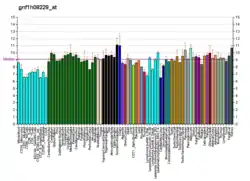GPR139
G-protein coupled receptor 139 (GPC139) is a protein that in humans is encoded by the GPR139 gene.[5][6] Recent research ('21) has shown that mice with loss of GCP139 experience schizophrenia-like symptomatology that is rescued with the dopamine receptor antagonist haloperidol and the μ-opioid receptor antagonist naltrexone;[7] as well, the recently developed, potent, and GPR139 receptor selective agonist TAK-041 (aka NBI-1065846)[8] is currently undergoing trials to gauge the efficacy for treating psychiatric conditions such as major depressive disorder and the negative symptoms of schizophrenia.
| GPR139 | |||||||||||||||||||||||||||||||||||||||||||||||||||
|---|---|---|---|---|---|---|---|---|---|---|---|---|---|---|---|---|---|---|---|---|---|---|---|---|---|---|---|---|---|---|---|---|---|---|---|---|---|---|---|---|---|---|---|---|---|---|---|---|---|---|---|
| Identifiers | |||||||||||||||||||||||||||||||||||||||||||||||||||
| Aliases | GPR139, GPRg1, PGR3, G protein-coupled receptor 139 | ||||||||||||||||||||||||||||||||||||||||||||||||||
| External IDs | OMIM: 618448 MGI: 2685341 HomoloGene: 45860 GeneCards: GPR139 | ||||||||||||||||||||||||||||||||||||||||||||||||||
| |||||||||||||||||||||||||||||||||||||||||||||||||||
| |||||||||||||||||||||||||||||||||||||||||||||||||||
| |||||||||||||||||||||||||||||||||||||||||||||||||||
| |||||||||||||||||||||||||||||||||||||||||||||||||||
| |||||||||||||||||||||||||||||||||||||||||||||||||||
| Wikidata | |||||||||||||||||||||||||||||||||||||||||||||||||||
| |||||||||||||||||||||||||||||||||||||||||||||||||||
References
- GRCh38: Ensembl release 89: ENSG00000180269 - Ensembl, May 2017
- GRCm38: Ensembl release 89: ENSMUSG00000066197 - Ensembl, May 2017
- "Human PubMed Reference:". National Center for Biotechnology Information, U.S. National Library of Medicine.
- "Mouse PubMed Reference:". National Center for Biotechnology Information, U.S. National Library of Medicine.
- Vassilatis DK, Hohmann JG, Zeng H, Li F, Ranchalis JE, Mortrud MT, et al. (April 2003). "The G protein-coupled receptor repertoires of human and mouse". Proceedings of the National Academy of Sciences of the United States of America. 100 (8): 4903–4908. Bibcode:2003PNAS..100.4903V. doi:10.1073/pnas.0230374100. PMC 153653. PMID 12679517.
- "Entrez Gene: GPR139 G protein-coupled receptor 139".
- Dao M, Stoveken HM, Cao Y, Martemyanov KA (March 2022). "The role of orphan receptor GPR139 in neuropsychiatric behavior". Neuropsychopharmacology. 47 (4): 902–913. doi:10.1038/s41386-021-00962-2. PMC 8882194. PMID 33479510. S2CID 231668867.
- Reichard HA, Schiffer HH, Monenschein H, Atienza JM, Corbett G, Skaggs AW, et al. (August 2021). "Discovery of TAK-041: a Potent and Selective GPR139 Agonist Explored for the Treatment of Negative Symptoms Associated with Schizophrenia". Journal of Medicinal Chemistry. 64 (15): 11527–11542. doi:10.1021/acs.jmedchem.1c00820. PMID 34260228. S2CID 235908256.
Further reading
- Vanti WB, Nguyen T, Cheng R, Lynch KR, George SR, O'Dowd BF (May 2003). "Novel human G-protein-coupled receptors". Biochemical and Biophysical Research Communications. 305 (1): 67–71. doi:10.1016/S0006-291X(03)00709-5. PMID 12732197.
- Ottolenghi C, Fellous M, Barbieri M, McElreavey K (March 2002). "Novel paralogy relations among human chromosomes support a link between the phylogeny of doublesex-related genes and the evolution of sex determination". Genomics. 79 (3): 333–343. doi:10.1006/geno.2002.6711. PMID 11863363.
- Takeda S, Kadowaki S, Haga T, Takaesu H, Mitaku S (June 2002). "Identification of G protein-coupled receptor genes from the human genome sequence". FEBS Letters. 520 (1–3): 97–101. doi:10.1016/S0014-5793(02)02775-8. PMID 12044878. S2CID 7116392.
- Gloriam DE, Schiöth HB, Fredriksson R (April 2005). "Nine new human Rhodopsin family G-protein coupled receptors: identification, sequence characterisation and evolutionary relationship". Biochimica et Biophysica Acta (BBA) - General Subjects. 1722 (3): 235–246. doi:10.1016/j.bbagen.2004.12.001. PMID 15777626.
- Matsuo A, Matsumoto S, Nagano M, Masumoto KH, Takasaki J, Matsumoto M, et al. (May 2005). "Molecular cloning and characterization of a novel Gq-coupled orphan receptor GPRg1 exclusively expressed in the central nervous system". Biochemical and Biophysical Research Communications. 331 (1): 363–369. doi:10.1016/j.bbrc.2005.03.174. PMID 15845401.
This article is issued from Wikipedia. The text is licensed under Creative Commons - Attribution - Sharealike. Additional terms may apply for the media files.





